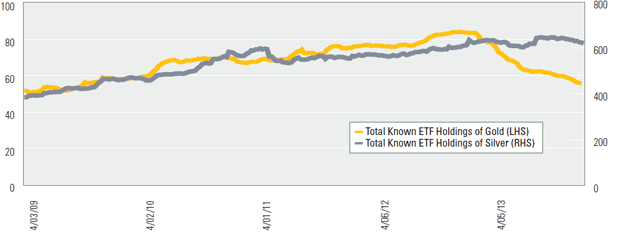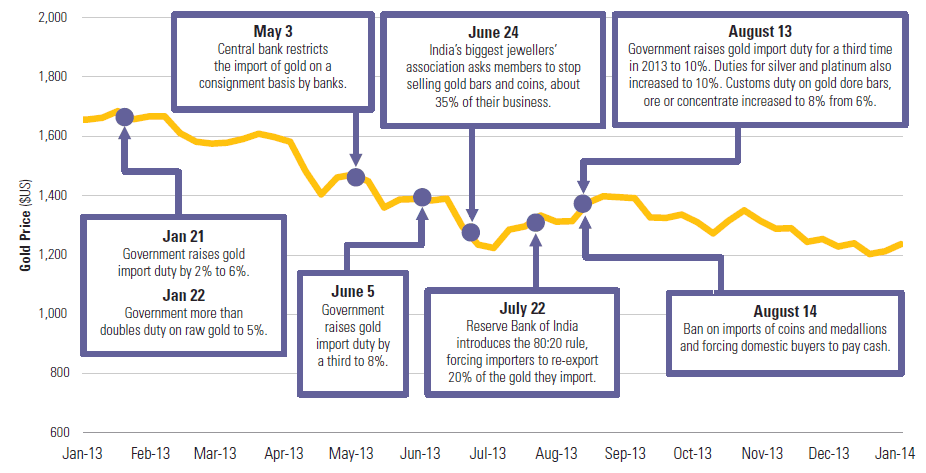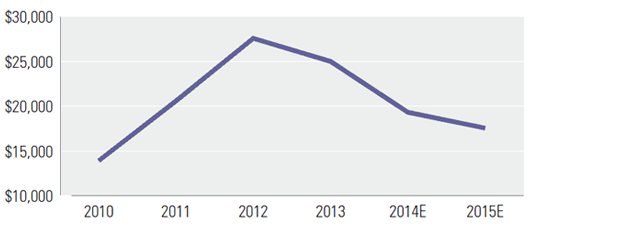– Sprott: “Manipulation Of Gold By Central Banks Cannot Continue In 2014” (ZeroHedge, Jan 17, 2014):
With Deutsche Bank quitting the price-setting panel for gold and Bafin bearing down on the manipulators, Eric Sprott provides some more color on where the manipulation in the precious metals markets is underway (and when it will end)…
Submitted by Eric Sprott of Sprott Global Resource Investments,
Introduction
As we very well know, 2013 was a difficult but also puzzling year for precious metals investors. The price of gold, silver and their related equities declined by a significant amount while demand for physical bullion from emerging markets and their Central Banks was exceptionally strong.
A common argument that has been made to explain the precipitous decline of the price of precious metals in 2013 is of investors’ disenchantment with precious metals, which had been piling up in exchange traded products as a way for investors to gain exposure to the metals. Proponents of this theory point to the large declines in the total holdings of those ETFs as evidence of investors fleeing the precious metal trade. As shown in Figure 1, the price of both gold and silver suffered very significant declines throughout 2013. Therefore, if this explanation is correct, one would expect the total ETF holdings of both metals to be lower as well.
However, this is not the case. As shown in Figure 2 gold ETFs suffered large redemptions whereas silver ETFs saw their holdings remain more or less constant throughout the year, and this without any observable change in trading patterns in the two largest ETFs; GLD and SLV (Figure 3 shows the ratio of the trading values in the ETFs over time). If redemptions are a symptom of investors’ disenchantment with precious metals as an investment, shouldn’t silver have suffered the same fate as gold? Indeed it should have, but we think the reason silver ETFs were not raided like gold was that Central Banks do not have a silver supply problem, they have a gold problem. As we have argued before, the raiding of gold ETFs is bullish for gold because it reflects an imbalance in the physical market.1
Figure 1: Gold and Silver prices declined significantly in 2013

Source: Bloomberg
Figure 2: ETF Holdings – Troy oz (millions)

Source: Bloomberg, tickers ETSITOTL & ETFGTOTL
In this article, we further argue that the April raid on gold and gold ETFs almost backfired by creating a tsunami of buying in India and increased demand to unsustainable levels. In May 2013 alone, Indians imported 162 tonnes2 of gold in a market where monthly global mine production is about 182 tonnes. A continuation of this trend, coupled with strong buying from other Emerging Markets and their Central Banks, would have been overwhelming. But, the response was swift. We suspect that, at the behest of Western Central Banks, the Reserve Bank of India reacted by enacting, in incremental steps, restrictive measures to prevent gold imports (See Figure 4 for a timeline of the major changes made by the Indian Government).3
Figure 3: Traded Value – Ratio of SLV to GLD

Source: Bloomberg. Traded Value is calculated by taking the total trading volume for a quarter and multiplying it by the average price over that quarter. A ratio of 1 indicates that SLV traded as much, in $ terms, as GLD.
Figure 4: Efforts to Curb Indian Gold Imports

Source: Bloomberg, Economic Times
Supply and Demand Imbalances: The Indian Effect
We have already discussed at length the supply and demand imbalance in an Open Letter to the World Gold Council, asking them to revise their methodology because it grossly understates the amount of demand coming from emerging markets.4 Our gold supply and demand table (Table 1) reflects the latest available data (2013 Q3 in most cases). World mine production, excluding Chinese and Russian production still stands at about 2,100 tonnes a year. Chinese net imports most likely exceeded 1,700 tonnes for 2013 (81% of world mine production) and demand from the rest of the world is rather stable.5
The overall picture has not changed much since our last article, with the exception of Indian imports. As of the second quarter of 2013, India had cumulative net gold imports of 551 tonnes, which annualizes to 1,102 tonnes.6 However, Q3 data shows net imports of only 31 tonnes (for a total of 582 tonnes YTD), which annualizes to 776 tonnes.
This incredible loss of momentum for “official” gold imports was the result of concerted actions by the Reserve Bank of India and the Indian Government. While the “official” justification for those restrictions is the large Indian current account deficit, this argument makes little sense. According to government officials, Indian’s taste for gold and the corresponding imports worsens the country’s trade balance, worsens its current account deficit and puts downward pressure on their currency, the Rupee.
But, without going into too many details, the classification of gold as a “good” in the trade balance is at best misleading. Since gold is more of an investment vehicle and is not “consumable” per se, it should instead be accounted for in the capital account of the balance of payments instead of the current account. Indeed, Switzerland, which is a large net importer of gold, reports its trade balance “without precious metals, precious stones and gems as well as art and antiques” to reflect fact that those are “investments” rather than consumption goods.9 In this case, why should India be any different and report their trade data excluding gold? To us, all the fuss about gold imports by the Indian Government is a red herring.
So, without the intervention in the Indian gold market, the shortage of gold would have wreaked havoc in the market, a situation that Western Central Banks could not tolerate.
Table 1: World Gold Supply and Demand 2013, in Tonnes

Sources: GFMS data comes from the WGC’s “Gold Demand Trends” publications for 2013 Q1, Q2 & Q3. Chinese mine supply comes from the China Gold Association and is up to October 2013, the annualized number is a Sprott estimate.8 Russian mine supply comes from the Union of Gold Producers and is up to 2013 Q3. Chinese data is taken from the Hong Kong Census and Statistics Department and covers the period Jan.-Nov. 2013 and is annualized to account for the missing month. Changes in Central Bank gold reserves are taken from the IMF’s International Financial Statistics, as published on the World Gold Council’s website for 2013 Q1, Q2 & Q3 and include all international organizations as well as all central banks. Net imports for Thailand, Turkey and India come from the UN Comtrade database and include gold coins, scrap, powder, jewellery and other items made of gold. The data is for 2013 Q1, Q2 & Q3. ETFs data comes from GFMS as well.
Conclusion and Outlook for 2014
As demonstrated in our Open Letter to the World Gold Council, there was a large supply-demand imbalance in 2013. The evidence presented here suggests that the decline in the price of gold in mid-2013 and the subsequent raid of gold ETFs (but not silver ETFs) was engineered by Western Central Banks to help solve their physical gold supply problem. However, the resulting increase in Indian gold demand exacerbated the problem. The solution was to restrict Indians from importing gold by all means possible in order to help the Western Central Banks regain control of the gold market.
However, the rate of drain in gold ETFs cannot continue forever; at the current pace of 930 tonnes/year, there are less than two years of gold left in ETFs. Moreover, Indians have proved highly creative at finding ways around import restrictions.10 Smuggling is on the rise and will most likely increase as smugglers become more sophisticated. Overall, we believe that interest in physical gold from emerging markets will remain a driving force.
Besides, mine production is unlikely to grow, as reflected by the significant decrease in capital expenditures expected for the major gold producers (Figure 5).
Accordingly, we believe that the manipulation of gold prices by central banks, as demonstrated by the above analysis, cannot continue in 2014. Therefore, we expect substantial increases in the price of precious metals as the true shortages become obvious.
Figure 5: Capital Expenditures ($mm) – XAU Index Members

Source: Bloomberg. Consensus analyst estimates are used for years 2013-2015.
P.S. Due to recent developments, we would also like to highlight some related media stories
Dec. 13, 2013: Bafin Said to Interview Deutsche Bank Staff in Gold Probe
Nov. 26, 2013: U.K., German Regulators Scrutinize Gold, Silver Pricing
Sept. 9, 2013: Sprott Thoughts: A Leaky Fix
1 See, for example, “Redemptions in the GLD are, oddly enough, Bullish for Gold”. 2 http://in.reuters.com/article/2013/06/03/gold-india-imports-idINDEE95207H20130603 3 See “Do the Western Central Banks have any gold left?”. Sprott Asset Management LP, Markets at a Glance May 2013. 4 See the full article at: http://www.sprott.com/markets-at-a-glance/open-letter-to-the-world-gold-council/ 5 As a reminder, because of our methodology which uses net imports as a proxy for total demand in countries that do not re-export gold, we exclude the “total industrial demand” estimate from the GFMS to avoid double counting. Thus, we underestimate total gold demand because we do not include industrial demand from the countries other than China, India, Turkey and Thailand. 6 As reported by the UN Comtrade Statistics. We use the total dollar amount reported and average quarterly prices to infer the total amount of gold imported and exported. 7 This is calculated by taking the total consumer demand for jewellery, coins and bars for 2013 Q1 & Q2 from table 10 of the WGC’s “Gold Demand Trends” and subtracting from it demand from the individual countries we have listed in the table (China/Hong Kong, India, Turkey, Russia and Thailand). 8 http://translate.google.ca/translate?hl=en&sl=zh-CN&u=http://www.cngold.org/&prev=/search%3Fq%3Dcngold.%26client%3Dsafari%26rls%3Den 9 See the Swiss Customs Administration website: http://www.ezv.admin.ch/themen/04096/04101/index.html?lang=en 10 See, for example: http://www.thestar.com/business/economy/2013/12/27/insatiable_appetite_for_gold_fuels_indias_smuggling_industry.html http://in.reuters.com/article/2013/12/03/india-gold-smuggling-idINDEE9B20HY20131203 http://articles.timesofindia.indiatimes.com/2013-12-29/chennai/45674552_1_airline-staff-gold-smuggling-flight-attendant